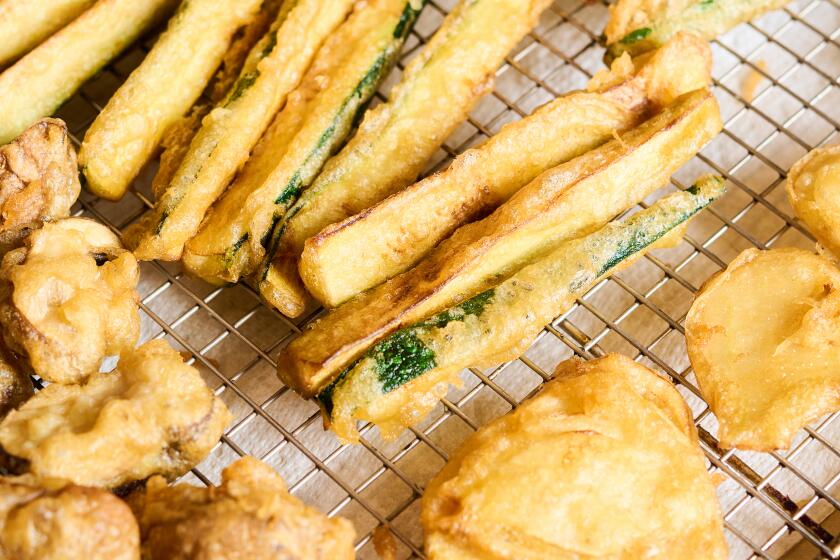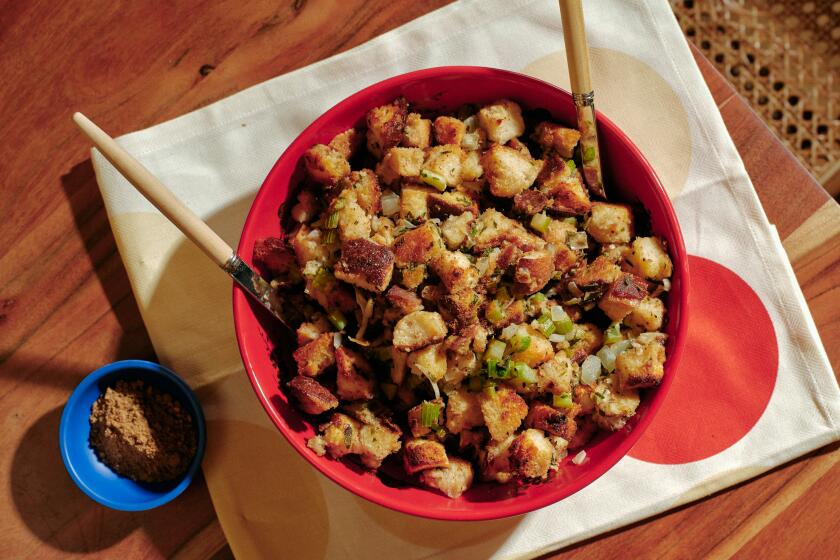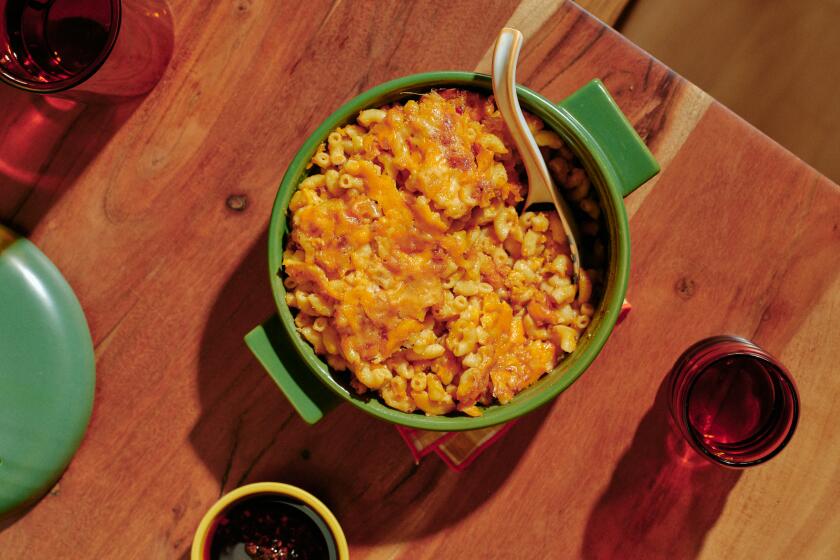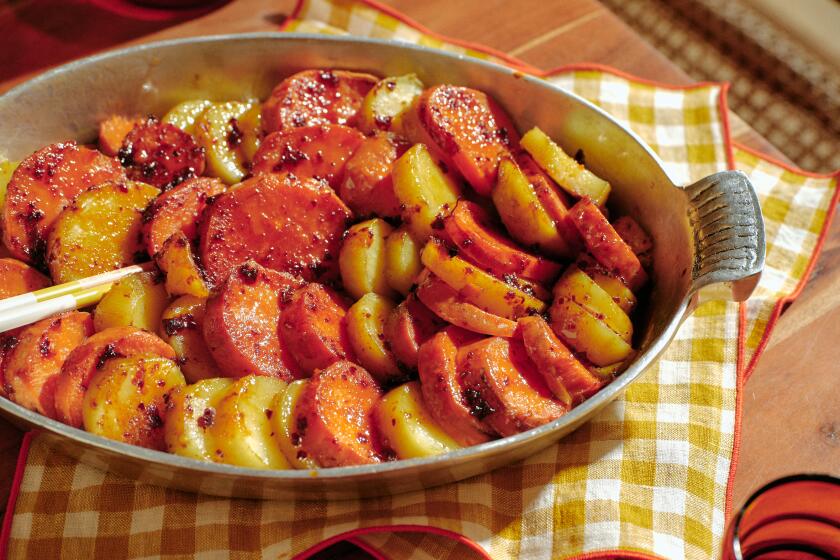Psomi & Alati's yellow split pea puree with deep-fried capers
In the Athens I knew when I first moved here almost 20 years ago, the taverna was still an institution. That was in the early 1990s, before a stock market boom, the Olympics, and the return of a generation of young, cosmopolitan Greeks who had left to study abroad and came back home with a taste for sushi and risotto.
That was then -- when Greeks shucked tradition for the excitement of the new, rendering the once-sacrosanct taverna obsolete. This is now, however, an era humbled by the sobering reality of an economic crisis of herculean proportions. Ever the optimist, I see a bright side. In this often ridiculously priced restaurant city, dining establishments are responding to the times.
In the last two years, Athens has seen a resurgence of the taverna. I am not talking about old places that suddenly shook off the dust and lighted up their signs, but a whole new generation of reasonably priced tavernas that have learned something from the country’s recent (and ritzier) past, pay heed to design and presentation and are reworking the classics with a twist.
Even better, many of the dishes these cozy places prepare are simple enough to inspire the home cook.
Comforts of home
The taverna has always been a place to go for home-cooked food. For most Greeks, dining out was as much an excuse for discourse as for dinner, and if the latter was a palette of familiar comforts, all the better.
One of my favorite contemporary tavernas is Kuzina on Adrianou Street, in the heart of the most touristy part of Athens. Despite its location, Kuzina is a favorite haunt for locals, most of whom come for chef Aris Tsanaklides’ robust, down-to-earth Greek fare. Tsanaklides, who trained at the Culinary Institute of America and has worked all over the world, sometimes weaves in Asian influences, such as naming the very Greek lakerda (tuna) hamachi and serving it with a classic mound of boiled wild greens, specifically a wild chicory native to Crete.
Kuzina is an example of the sophistication that characterizes many modern tavernas. “Greeks became Westerners,” Tsanaklides says. “They want a fancier package now, but they also want the familiar tastes and smells they grew up with. The taverna is in our DNA.”
One of my favorite dishes at Kuzina is a take on one of the most traditional taverna recipes, melitzanosalata, the smoky Greek roasted eggplant salad. Tsanaklides butterflies the flame-roasted eggplant, chops it into chunks and serves it in the skin, tossed with feta, garlic oil and herbed olive oil.
Another classic, one of the greatest Greek comfort foods, is the tubular spaghetti and ground meat sauce sometimes referred to in Greece as “ferry boat pasta” because it is one of the standard dishes prepared by galley cooks on all those slow boats to the Aegean islands. Tsanaklides uses the same tubular spaghetti and tosses it with a meat sauce composed of ground regional sausages and spicy peppers, paying homage to a famous sausage-and-pepper dish from Mt. Pelion in the middle of the country.
Another beguiling taverna dish comes from a place I recently discovered, a tiny eatery called To Mageriko tis Nagias. Roughly translated, the name means Nagia’s Cookery. (Mageriko refers to a type of restaurant in which the kitchen is quasi-open and the day’s food on display in its pots behind a glass counter.)
The dish I fell in love with here is a delicious marriage of orzo -- kritharaki in Greek -- extra-virgin olive oil, fennel and smoked eel, a local Greek delicacy from the shores of Messolongi on the country’s western coast.
Nagia Pigaditi opened her taverna three years ago in the neighborhood of Kallithea, about a 10-minute taxi ride from the center of town, and she designed it to look like the tavernas of the 1960s, with marble-topped tables, lots of wood and an old-world patina.
Her home-cooked food is based clearly on the Greek classics but with a personal touch. Octopus stew in Pigaditi’s hands becomes a tangy concoction of the cephalopod simmered with capers, sun-dried tomatoes and white wine. Her chickpeas, slowly baked and succulent without being soupy, are an homage to the clay-baked chickpea dishes of several Greek islands.
“People respond to simple food,” Pigaditi says. “Especially now, with all that’s happening here, food needs to provide comfort, even when you eat out.”
While all of the classic taverna fare, the dips and spreads and small pies, for example, are part of her standard menu, a long list of daily specials reflects what is in season.
“Artichoke and asparagus season are over,” she says. “Now it’s time for the ladera [the olive oil-based vegetarian stews]. I try to serve clean flavors, seasonal dishes, the kind of food our mothers cooked on Sundays a generation ago.”
Pigaditi’s restaurant is in a neighborhood that is easy to access from the center of town. But most of the best tavernas, new and old, are in the sprawling fringes of Athens. The metro makes traveling easy, but so do GPS-equipped taxis.
A place I go to for some of the most original taverna fare is Psomi & Alati, whose name refers to the most elemental foods: bread and salt.
Chef-owner Yiannis Loukakos once worked the stoves at some of the haute-iest restaurants in Athens but gave up the glamour for the steadier income afforded by his reasonably priced taverna.
“In Greece, the haute cuisine places are mostly a bubble that’s burst,” Loukakos says. “There are very few that are worth their prices.”
In the giddy days when cash splashed around this city aplenty, high-end restaurants sprouted up all over the place. “But we forgot our roots,” he says. “We forgot what casual dining, which for a Greek means the taverna, is all about.”
Psomi & Alati looks like an old grocery store, a design trend, in fact, among many of the new tavernas in Athens. Its shelves are lined with cans and Mason jars and traditional Greek brands with a decidedly retro look.
Loukakos takes the flagship plate of every Greek taverna -- fava, a puree of yellow split peas -- and sprinkles it with deep-fried capers, in a nod to the caper-tomato topping on the fava of Santorini, where it is something of a regional classic.
Cheese croquettes, the cutting edge of taverna fare in the simpler 1980s, are served with a spicy-sweet orange sauce that counters the saltiness of the croquettes. I love another of his modern interpretations of a taverna dish, beet salad, which he tosses with pistachios, green beans and basil, the last not an herb Greeks use much in the traditional kitchen.
Gemista -- stuffed tomatoes and peppers -- become the inspiration not for a rice dish at Psomi & Alati but for a simple bulgur pilaf that captures the same palette of flavors: dill, lemon, raisins, pine nuts and olive oil. It is fresh and satisfying. He stuffs his grape leaves with the same mixture.
“I came from a haute-cuisine background,” says the chef, “and I steal techniques from high-end kitchens to prepare my simpler taverna fare.” One example is his Greek fries, which are cooked first in a sous-vide pack, then fried to order. “The result is healthier and easier on the kitchen during the service rush,” he says.
More choices
Kuzina, Nagia’s and Psomi & Alati are just three of many tavernas that have cropped up over the last few years as restaurant owners adapt to changing times. The good news is that for visitors to Athens, there are now plenty of choices when it comes to finding good, simple Greek fare that is reasonably priced. The places I mention are in the $25-to-$35 range per person, with wine.
But maybe the better news is that so much of the new taverna fare is the kind of food that translates perfectly to the home kitchen. While Greek home cooking often has been sorely lacking in the Greek restaurants across America, Greek taverna cooking is simple enough to travel far afield of Athens.
Caramelized onions
In a large, heavy skillet, heat the olive oil over medium heat until the oil is hot, then add the onions and toss to coat. Raise the heat and cook, stirring frequently, until the onions begin to color.
Reduce the heat to low and sprinkle in the sugar. Continue to cook the onions until they turn a deeper golden color, about 15 minutes.
Stir in the balsamic vinegar and continue to cook slowly until the onions are soft, darkly caramelized and sweet, about 45 minutes, stirring occasionally.
Season to taste with salt and set aside in a warm place until the peas are ready.
Fried capers
In a small skillet, heat the olive oil over high heat until hot but not smoking. Add the capers and fry, turning carefully, until they puff up and begin to pop. Strain the capers immediately with a slotted spoon and drain on paper towels. Set aside in a warm place until the peas are ready.
Split pea puree and final assembly
In a wide, deep pot heated over medium heat, add 4 tablespoons olive oil. Stir in the onions and garlic and sweat until the onions are softened, 4 to 5 minutes.
Stir in the yellow split peas and toss to coat in the oil, then stir in the chicken broth, water and one-half teaspoon salt. Cook, stirring occasionally until the peas have absorbed all the liquid and are the consistency of chunky mashed potatoes. Season to taste with salt.
Puree the peas with an immersion blender and add the remaining olive oil and lemon juice, to taste, if using. Continue to puree until the mixture is silky and smooth. This makes about 5 cups puree.
Spread the pea puree onto a large platter and top with the caramelized onions and fried capers. Serve immediately.
Get our Cooking newsletter.
Your roundup of inspiring recipes and kitchen tricks.
You may occasionally receive promotional content from the Los Angeles Times.














